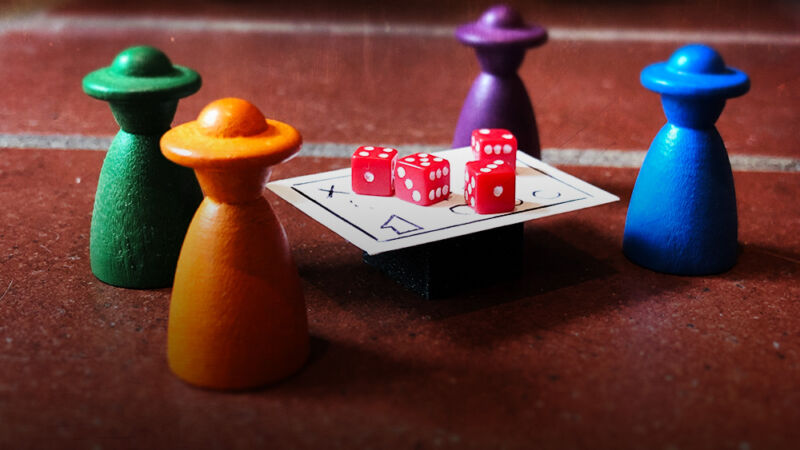
Trapped indoors? Brain turning to mush? Can't bear to watch another minute of TV? We've got a few suggestions: modern board games well-suited to the most common quarantine scenarios of solo play, two-person gaming, and family time. Save the meetups and conventions for when the world gets back to normal; for now, play with the ones you're locked up with.
Board games have enjoyed a massive resurgence in the last decade, and our fellow fans no doubt have personal libraries already. But for anyone newer to the hobby, we've pulled together some recommendations that should keep you away from coronavirus news for an hour—while giving your brain a gentle workout.
Most of the games below are available on Amazon, but some might require a visit to your friendly local gaming store's website—and right now is the perfect time to support a local shop, if you can!
Family games
These are not "kids' games" but legitimately engaging titles capable of being played (and enjoyed) by whole families. Most aren't suitable for kids under 6, but they have all been tested in our own families. Even the most complex on this list—which is ordered from easiest to most challenging—can be enjoyed by a sharp 12-year old.
Dixit
3-6 players, 30 minutes, age 8+, $28 on Amazon

Dixit is in some ways a slightly more complex Apples to Apples or Cards Against Humanity, but the cards here are all wordless pictures. In each round, one player is the "storyteller" and says a word or phrase that represents a card from their hand. All the other players try to match the idea with a card from their hands, and then all the cards are shuffled together and spread out by the storyteller. The non-storytellers then vote on what they think the storyteller's card was. If nobody—or everybody—figures out the storyteller's card, the storyteller gets nothing and all other players score 2 points. The storyteller must give a good clue but not make it too obvious—if they're able to do this, both they and the correct-guessers get 3 points. Meanwhile, non-storytellers get a point for everyone who voted for their card.
The game works because there are many different elements on each (delightfully strange) card, and they're all open to wild interpretation. We like to take things a step further by allowing clues to be anything—noises, a dance, whatever gets your point across. Dixit works wonderfully in some groups and not at all in others, and you probably know if it's right for your group from the description. For a more "gamey" version of the same concept, check out Mysterium.
Kingdomino
2-4 players, 15-20 minutes, age 8+, $18 on Amazon
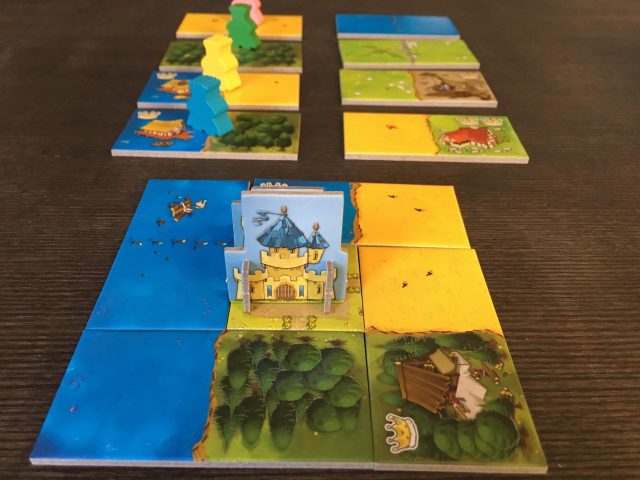
Kingdomino is a dead-simple tile-laying game in which you try to group different areas—ocean, wheat field, mine, etc.—of your kingdom in order to score points. Some tiles have crowns on them. At the game's end, each set of contiguous area tiles is scored by multiplying the size of that area by the number of crowns on its tiles. Simple? Sure, except that you have to keep your kingdom within a 5x5 grid, and every area tile must be placed such that it touches an existing tile of that type. To make this even trickier, new tiles come out of the box and are chosen in player turn order—but the tile you take in one round determines your player order in the next. Take the better tile now and choose last in the next round? Or grab something not quite as good that will still get you first or second pick next time?
This is a smooth, quick-playing game that has worked well with both kids and adults—even providing some surprisingly decent choices for seasoned gamers. A worthy winner of 2017's important Spiel des Jahres (Game of the Year) award in Germany.
Splendor
2-4 players, 30 minutes, age 10+, $31 on Amazon
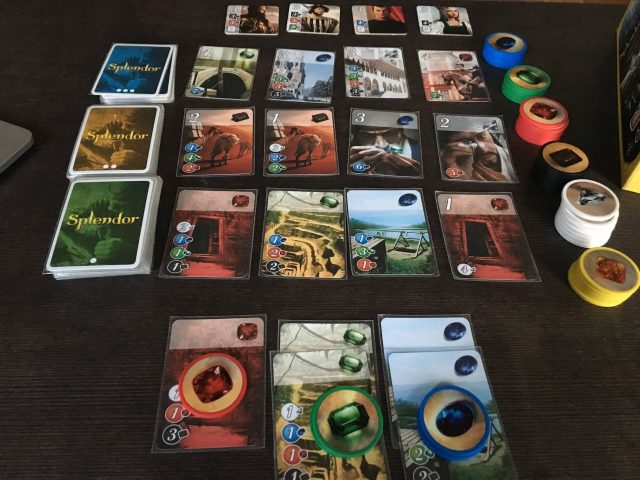
Azul
2-4 players, 30-45 minutes, age 8+, check your local store
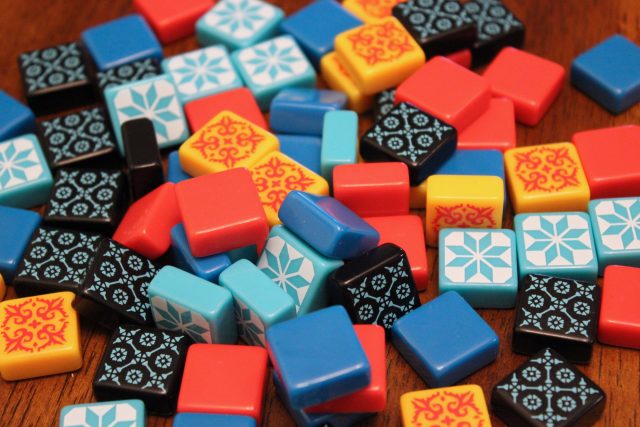
The words "instant classic" are overused in board gaming, but if Azul doesn't fit the bill, no game does. The title took home the prestigious Spiel des Jahres (Game of the Year) award in Germany, and it has quickly solidified its place in the "gateway" games pantheon.
Based on Islamic-inspired Portuguese tiles called azulejos, this family-weight abstract involves collecting sets of similar tiles and slotting them into rows on your personal game board. When a row is completely filled, one of its tiles is moved over into the square pattern to the right, garnering bonuses depending on placement. Turns are quick, and each set of tiles you grab creates both problems and opportunities for other players. There's a tinge of "meanness" for players who are sensitive to that sort of thing, but it's essential to Azul's wonderful interactive tension.
Gorgeous bakelite-style tiles seal the deal on a beautiful production. Read our full review here. (If sold out, you might consider the well-regarded sequel Azul: Summer Pavilion.)
Welcome to...
1-100 players, 25 minutes, age 10+, $24 on Amazon
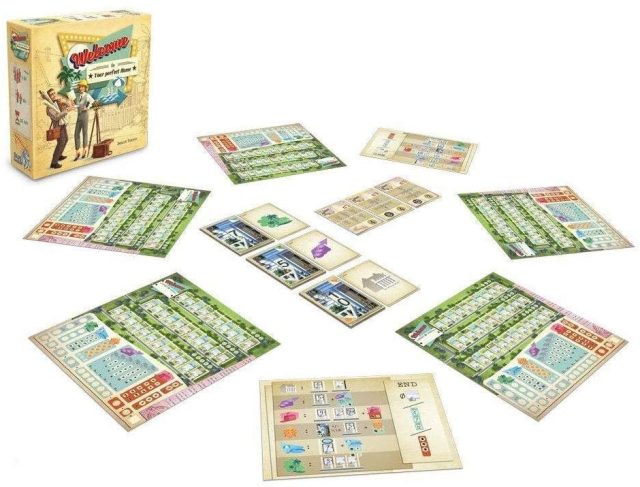
One of the hottest trends in board games over the past few years has been the “roll and write” genre, in which players roll and draft dice, then mark the results on a scoring sheet. We’ve played a ton of these games, and the unfortunately named Welcome to… is easily one of our favorites.
The game has you and your friends building up your own little suburban neighborhoods. You don’t roll dice here, though; instead, a big deck of cards gets split into three piles, and in every round, a card from each pile is turned over. Players then pick one card to mark down on their sheets (multiple people can pick the same card). The cards each display a number and a symbol. On your player sheet are three rows of houses and a few other scoring trackers. You write the number on a house to essentially “build” it, keeping in mind that the numbers must ascend numerically from left to right in each row—which, believe me, is way harder to manage than it sounds. The symbols provide special effects—take the “fence” symbol and you can clump your houses into estates, for example, or install a pool on spaces with the pool symbol.
The game presents some surprisingly difficult decisions—I really need to pick that fence card to finish my estate, but the number on that other card is PERFECT for me—and it is easy enough to teach to even board game novices. There’s no minimum or maximum player count; anyone with a sheet can play. And with its 25-minute playtime, it’s a perfect little filler.
Dice Forge
2-4 players, 45 minutes, age 8+, $32 at Amazon

Pure engine-building fun with chunky plastic dice. On each turn, you roll your dice, store up resources, and then purchase cards that give you special abilities or—and here's the game's "gimmick"—buy even better die faces. That's right: much of the game consists of buying more powerful resources from a large tray of faces, then replacing an existing face on one of your dice. By game's end—about 45 minutes—you're rolling killer combos every time.
Dice Forge has one of the most gorgeous presentations I have ever seen in board gaming, the die faces come off with a satisfying "pop," and there are more available card powers than you can use in a single game. Terrific family entertainment.
Ticket to Ride: Europe
2-5 players, 30-60 minutes, age 8+, check your local store
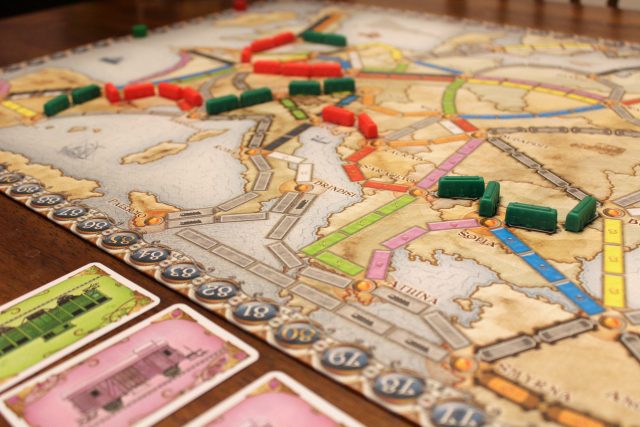
Ticket to Ride is fondly remembered by a considerable number of gamers as their first step into the hobby, a lovely peek at the hinterlands that exist beyond Monopoly. Usually, it must be said, this is because it has Monopoly-esque elements: raw capitalism, competition for areas (in this case rail routes between cities), and lots of plastic pieces you use to block your opponents (in this case, train carriages). Players take it in turn to choose cards from a deck containing eight different colors of cards (plus wilds). Once enough cards have been collected, players can use them to lay trains on routes of the same color between cities, hopefully fulfilling hidden orders that score you points by collecting distant areas to one another. But if someone takes the easy route from A to B before you, the game becomes a frenzy of sudden recalculation—if you don't complete all your orders, you lose the points.
There are loads of versions, covering the US, India, Germany, the UK and elsewhere in various time periods, but we've chosen Europe as the definitive place to start; it's a slightly larger, more involved map than the US, and the box comes with a few additional elements that make the game deeper. This will be a game that no one will be disappointed to see hit the table, even if people can grow out of it. (It also has a fine app.)
Parks
1-5 players, 40-60 minutes, age 9+, $49 on Amazon
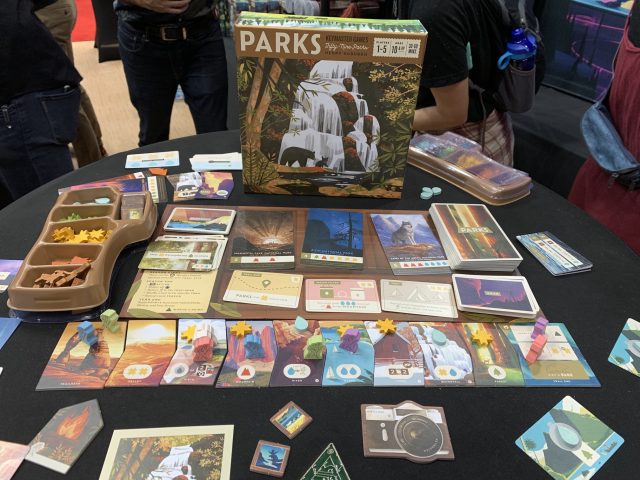
Featuring artwork from the excellent 59 Parks Project, the game’s components are front and center, making for one of the most eye-catching games of the year (and can we talk about its perfect box insert?!) But a game is nothing without compelling gameplay, and Parks brings plenty of fun decisions for newer gamers and old hands alike. The game tasks players with making their way down a hiking trail using two hikers, with each space granting you resources or special actions. Any hiker on a space blocks other hikers from landing on it, so the trick is finding the best spots to exploit and the best time to hop on down the trail.
At the end of the trail, you can trade your resources (sunlight, water, mountains, trees, etc.) to visit a national park. Does this make sense? Not really. Is it fun? Yes. You’ll also be taking pictures of your travels, buying equipment to help you along your way, and filling up your trusty canteen whenever the opportunity presents itself. Now that you're stuck inside, pick up this delightful little game for the outdoors enthusiast in your life.
Quacks of Quedlinburg
2-4 player, 45 minutes, age 10+, $53 on Amazon

A ridiculously fun press-your-luck bag-building game about being a charlatan at a medieval fair, hawking crazy potions that you mix up out of dubious components plucked unseen from your stash. Each one makes the potion stronger, but beware the white berries—too many and your cauldron will bubble over. The game has wonderful, whimsical art, terrific replayability, and great components—including rubies and rat tails. And because every player builds their potions simultaneously, this is another game with almost no downtime between turns.
Quacks won the prestigious Kennerspiel des Jahres game award in 2018, and with good reason. You're not technically required to love it, but if you're a gamer (or in love with one), you should at least try it.
Kingdom Builder
2-4 players, 45 minutes, age 8+, $43 on Amazon
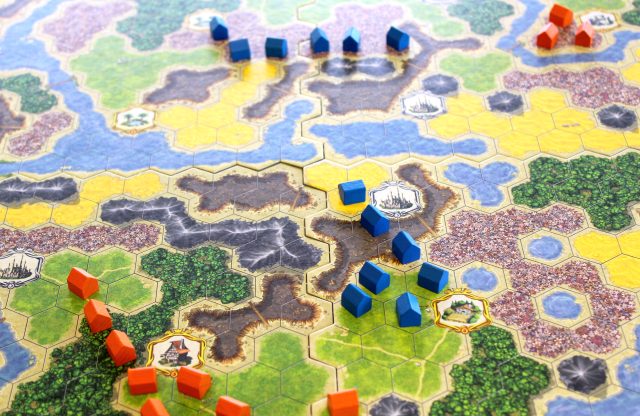
How's this for "accessible gameplay"? Kingdom Builder, which won Germany's prestigious Spiel des Jahres award in 2012, can be taught in less than five minutes and gives each player just one card per turn—but it also offers a modular board, different scoring cards for each game, and unique bonus powers. While the rules here are easy enough to grasp, Kingdom Builder goes well beyond our gateway suggestions in the strategic thinking it requires. Placing three of your settlements each turn onto a large and lovely map sounds simple enough in practice, but making proper use of the required terrain cards, snagging the most useful bonus powers for your strategy, and puzzling out ways to earn maximum points based on each game's scoring conditions is far more difficult than it looks—especially with three or four players cluttering up the board. Multiple (good) expansions are available, including one that adds a fifth player color, but the base game should keep you occupied for quite some time.
Lords of Waterdeep
2-5 players, 60-120 minutes, age 12+, $42 on Amazon
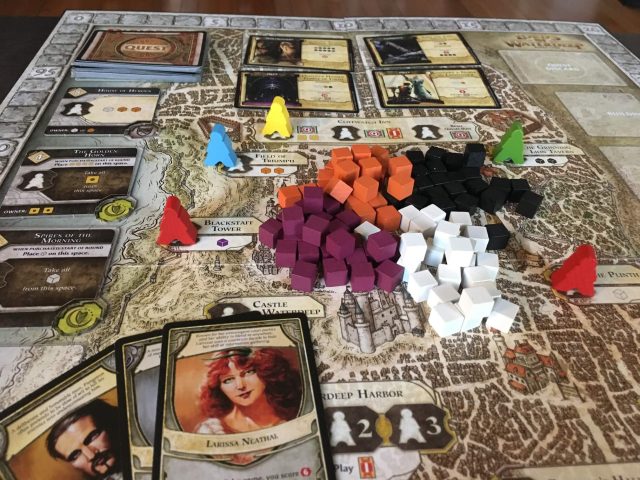
Lords of Waterdeep is a game set in the Dungeons and Dragons universe, but it's not a "D&D game." Absent are the dice, dungeon tiles, and sword-wielding minis you'd expect; instead, the game comes with meeples, wooden cubes, and a victory point track—all the markings of a Eurogame. If you've been wondering what this whole "worker placement" craze in board games is all about, Lords of Waterdeep is the perfect introduction. Simple rules combine with addictive "collect resources to complete quests" gameplay to deliver a full board game experience that newer players can sink their teeth into. The theme is light and fairly inconsequential, so even those who don't know the difference between a goblin and a bugbear can still have a blast.
Wingspan
1-5 players, 40-70 minutes, age 10+, $60 direct from Stonemaier Games
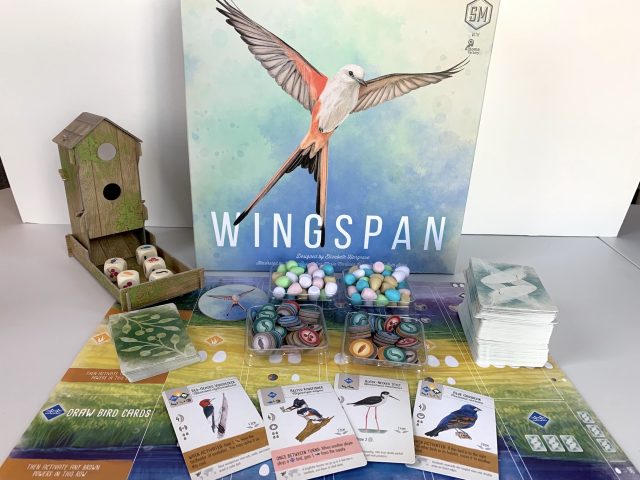
If you only heard of one board game released in the last year, chances are good it was Wingspan. Stonemaier Games’ trademark stellar production is on full display here with a package that includes colorful player boards, 170 unique and beautifully illustrated bird cards, plastic eggs so lovely you’ll constantly fight the urge to eat them, and, yes, a bird house dice tower.
Birds are represented by cards, and you slot those cards into rows on your personal player board to score points and gain special powers. Each row is keyed to a certain action—scavenging for food, laying eggs, etc—and when you perform that action, you also activate all the special powers of the birds in that row. Start with nothing, and by the end of the game, you’re drowning in worms and eggs (this is… a good thing).
Wingspan is a perfect “next step” game that’s quick to teach and a joy to play no matter your gaming experience level. Read our full review here.
Carpe Diem
1-4 players, 60 minutes, ages 10+, $47 on Amazon

Stefan Feld, the German game design genius behind classics like Castles of Burgundy, recently put out a terrific midweight title called Carpe Diem in which you're... some kind of Roman? Anyway, this is a tile drafting and placement game that never lets you stop thinking. Which direction do I want to move my "patrician" on each turn? Which tile should I draw from the patrician's resting spot? Where should I put the tile on my player board? Do I earn any immediate bonuses for completing a building? Will I earn end-game "frame" bonuses for completing my building in this particular spot? Do I pick a bonus point "banderole" for filling a spot? How do I want my board scored this round? (Yes, even choosing the scoring conditions in this game is itself a minigame.)
Thinky but fast-moving, this one is easy enough for a sharp-minded tween to play but great with adults as well. It's a polished effort that has no unnecessary rules bloat, doesn't overstay its welcome, and comes with some delightful grape, fish, and veggie meeples.
Two-player games
Spending a lot of time inside with one other person? These two-player titles make a terrific break from staring at your respective phones in silence.
7 Wonders Duel
2 players, 30-45 minutes, ages 10+, $30 on Amazon
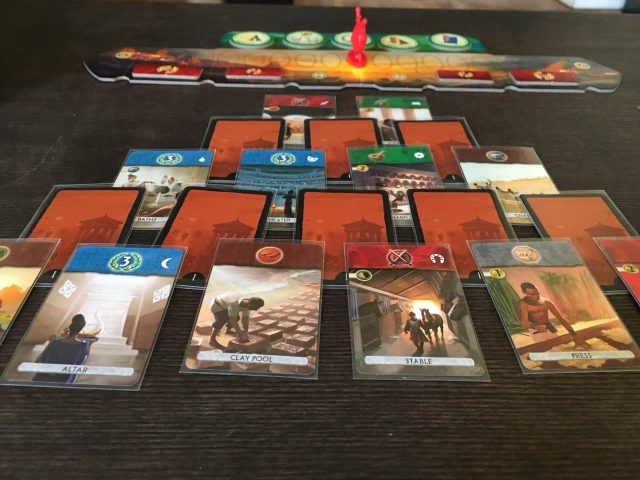
7 Wonders Duel, a two-player version of the modern classic 7 Wonders, retools the civ-building-with-cards mechanism of the bigger game into something quick, tense, and interesting from turn one.
On every turn, spread across three "ages," you select an available card from the table in front of you and either build it with resources, discard it for money, or use it to build one of the game's titular "wonders." Building cards gives you wood, stone, glass, bricks, parchment, scientific achievements, military power, or luscious, unadulterated victory points.
You win the game in one of three ways: victory points, military invasion, or complete scientific dominance. (A clever military track across the top of the game spaces uses a "push-pull" mechanism between players to track military supremacy; move the shield pawn all the way into the opponent's base and the game ends immediately.) Along the way, you'll build your personal set of wonders to provide powerful bonuses, more resources, and occasionally additional turns.
While the full 7 Wonders uses card drafting to make these same mechanisms work, Duel relies on drawing from specific geometrical card arrangements, such as a pyramid in which every other row of cards is face down and certain cards are only available once the cards below them are removed. This turns the process of card collection into a puzzle of its own, as you don't want to expose powerful cards that you want (or cards you want to deny your opponent) until you're in a place to snap them up.
Best of all, the whole thing offers a meaty experience in around 30 minutes and stores its goodness in a small box. Stop what you're doing right now and go buy this game.
Jaipur
2 players, 30 minutes, ages 10+, $25 on Amazon
Atop the pantheon of two-player games sits the storied "couples game," and Jaipur, a game about trading goods in India, is perhaps the perfect realization of the form. It's a snap to teach, it plays in about 30 minutes, and it's interactive in the best of ways.
At the beginning of the game, both players are dealt a hand of cards representing various goods—spice, silk, leather, etc.—and camels, which aren't goods but can be used in trades. A central market of five more goods cards is dealt to the middle of the table. On your turn, you're presented with a deceptively simple choice: get new goods or sell the goods you already have. To get goods, you can either trade cards with the market or take a card from the market without giving anything up. If you decide to sell, you'll discard all the goods of a certain type and be rewarded with tokens representing money. The value on the money tokens goes down as more and more goods are sold, so you want to sell quickly to get the best price. But conflicting with this "SELL NOW" mentality are the stacks of bonus tokens. The more goods you sell at once, the better bonus you'll get. Do you sell your two silk now to get the best price, or do you hold out and hope to collect more so you can get that nice, juicy five-card bonus token?
Jaipur is a great game of tug-of-war that provides a surprising amount of tense decisions within a small decision space.
Air, Land, & Sea
2 players, 15-30 minutes, ages 14+, check your local store

At first glance, there’s nothing special about Air, Land, & Sea. Like other games of its ilk, such as Battle Line or Omen: A Reign of War, your goal is to win control over two of three theaters — the titular land, air, and sea. From a pool of only eighteen cards, both players draw six and commence to do battle. Each card is limited to a single assigned theater, though it can be played face down anywhere (this usually lessens its value). It’s clever enough, and the cards are designed to a near-perfect balance, but this isn’t anything to write home about...
Until you realize you can “withdraw” from a battle entirely. Doing so gives your opponent points based on how many cards you’re still holding, and the earlier you withdraw, the fewer points your opponent gets. As you chase a winning score, it isn’t long before Air, Land, & Sea becomes a careful showdown between strategic geniuses. Show too strong a hand early on and your opponent may only yield a few points; press too hard and your best cards might be flipped by opposing abilities. It’s a game of numbers, tempo, and tricking your opponent into surrendering when they might have won—and it’s sublime.
Dual Powers: Revolution 1917
1-2 players, 30-60 minutes, ages 13+, $46 on Amazon
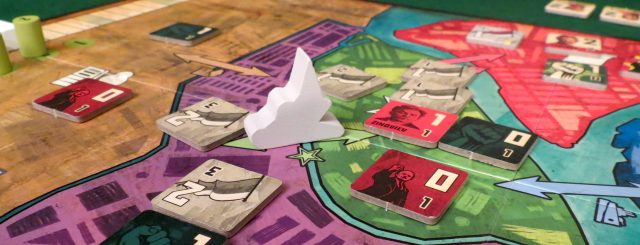
I’m not sure I could pay any greater compliment than to say that Dual Powers makes calendars deeply interesting. In this Russian showdown between the Provisional Government and the Bolshevik Party for the very soul of the nation, every card lets you take an action, but it also ticks off a few days from the game’s calendar. If you successfully enact a card on the right days, you’re allowed a bonus action, effectively taking advantage of a holiday or a parallel demonstration to double your efforts. In fact, everything is up for grabs.
Where you’ll score on any given round—or where your opponent will score if they manage to figure out the location of your scoring card—determines which bridge is impassable, even which side controls the will of the people. This jockeying is incisive in its sparseness, without a single wasted card or component. The result is breathlessly taut, allowing barely any wiggle room for missteps, at least until you trick your opponent into sending their mobs to the wrong district of the city. Careful you don’t fall afoul of the victor. That’s how Trotsky wound up with an ice pick lodged in his skull.
KeyForge: Call of the Archons
2 players, 15-45 minutes, ages 14+, $40 on Amazon (starter set)
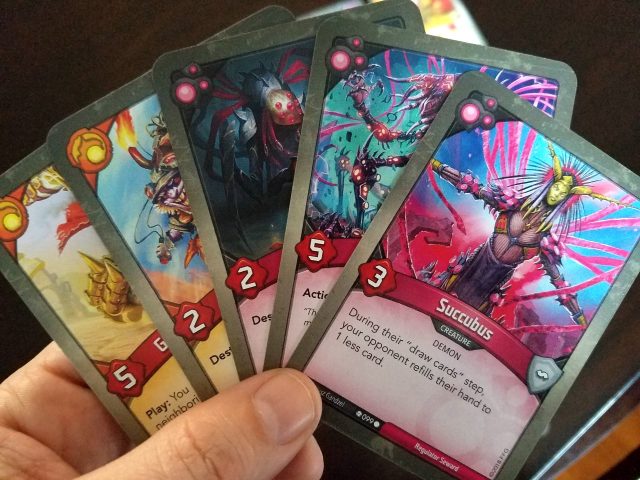
Any self-respecting list of two-player tabletop games must include a card dueling game, and our current ick is Richard Garfield's 2018 release Keyforge: Call of the Archons. The game's schtick is an odd one: Keyforge is a CCG-style card game that forbids deckbuilding. Instead of asking you to buy booster packs or chase down coveted cards on the secondhand market to build a killer deck, KeyForge wants you to let it do heavy lifting for you. Specifically, an algorithm assembles every deck and assigns it a unique name and card back—you buy it and play it, no alterations allowed.
But beyond the intriguing distribution premise, the game is a ton of fun to play. There's no mana economy to manage; instead, each deck has cards from three of the game's "houses," and you can only play and activate cards from the house that you declare as active at the beginning of your turn. Creatures you play can attack each other, of course, but the goal of the game is not to reduce your opponent's health to zero. Instead, three "keys" must be constructed by using the game's "ember" resource, and collecting ember is one of the actions available to creatures, forcing you to choose between attacking and resource gathering. There are a lot of fun and interesting decisions to make.
KeyForge has some baked-in mechanics for balancing powerful cards and decks, but I'm not sure the game has competitive legs. As a kitchen-table brawl between friends, though, it's a blast. A starter set, which includes tokens and four decks (two handcrafted "learning" decks and two regular, algorithm-constructed decks) is available for around $40, or you can just pick up two $10 packs and see what you get.
Schotten Totten
2 players, 20 minutes, ages 8+, $14 on Amazon
-
Battling over the "stones" at the center of the table.
-
A two-player gem, Schotten Totten sees players battling over "boundary stones" arranged in a line across the center of the table. On each turn, you can add one card from your hand to the space in front of any stone; once each side of that stone accumulates three cards, a "battle" is fought over the stone. The best three-card hand wins, so numerical runs and identical colors are essential if you want to claim stones. Claim enough stones and you win bragging rights over the size of your Scottish territory. A set of optional "tactics" cards grant the holder special powers to manipulate cards after play; they're fun, but I prefer the straightforward base game.
Like many Reiner Knizia games, this one is clean, simple, and largely themeless, and it makes a fabulous two-player filler. Games can be bashed out in 15 minutes, so this is a terrific weeknight "after dinner" game, made even better by the fact that it works well with kids (8 and up, unless your child is a prodigy, which I'm sure yours is).
Schotten Totten got a lovely 2016 reprint from Iello with some nice (if goofy) art, but if you don't like the aesthetic, pick up an earlier edition of a copy of Battle Line (the same game, but themed with Macedonian warriors).
Star Realms
2 players (1-4 players with Frontiers edition), 30 mins, ages 10+, $22 on Amazon
-
On each turn, you play your hand cards and tot up the money earned, damage inflicted, and health gained. Here, the green faction scores a faction bonus because two cards were played in the same hand.
-
Some of the solo and co-op scenario cards that come with the standalone version of Star Realms: Frontiers.
Sometimes you just want to blow up your spouse's galactic empire, you know? And at moments like those, the discerning interstellar tyrant-in-training turns to Star Realms for a visceral, adrenaline-fueled battler.
The game is the distilled essence of deck-builders + direct combat. On each turn, you will play all five cards in your hand, collecting money to buy new cards from the central market and dishing out attack points on your opponent. Then you discard those five cards, draw five more, and sit back to absorb some incoming photon torpedoes during your opponent's turn. The first player whose health (inexplicably called "authority" here) drops to zero loses.
What elevates the experience is the speed and elegance of the gameplay, the rapid progression from weakling starter deck to the owner of killer dreadnoughts, the existence of "bases" that persist across turns, and the factions. Oh my, those factions! Each has a different color, a different art style, and a different play style. But you need to pick your strategy carefully, because specializing in a faction will reward you; hands which feature multiple cards from the same faction will usually generate killer bonuses.
The best way to describe Star Realms is "pure fun." It's not the deepest strategy game, and its rules aren't complex. But every hand is a joy to play, and the game has a remarkable sense of acceleration. Your final turns will have your space empire inflicting damage so incredible as to have been unthinkable at the game's beginning—just 20 minutes before.
Star Realms was originally a two-player only game, but if you're seeking it out today, we'd recommend the standalone Star Realms: Frontiers. This revamped set fixes the unusable health trackers from the first version, tweaks the cards slightly, allows up to four-player battles, adds "challenge" cards for co-op and solo play, and comes in a nifty little box.
Lost Cities
2 players, 20 minutes, ages 10+, $26 on Amazon

The best two-player games are titles that could only exist as two-player experiences. Lost Cities is one of those games.
The game is nominally about explorers setting off on expeditions to discover mythological cities lost to time. What it's really about, though, is two players trying to score points through careful hand management, a judicious amount of luck-pressing, and knowing when to cut your losses.
Players set off on expeditions by playing cards—which come in five different colors and are numbered 2-10—in ascending order on their side of a central board. When you play a card to start an expedition, you're putting yourself on the clock—committing to a color puts you at a 20-point deficit until you can claw your way back to the positives. Cards score their face value, so you'll need to play three or four cards before you break even. "Handshake" cards can be played before you commit to a suit and act as multipliers for your score in that color, both positive and negative. Instead of playing a card, you can discard a card you don't want, but be careful—your opponent can grab your discards on their turn.
There's a bit of luck involved, but that's part of Lost Cities' draw. The only real downside is that its scoring can be a bit opaque and mathy, which is at odds with the game's simple, elegant ruleset. Still, there's a ton going on in this little game, and we highly recommend it. You can also check out the excellent iPhone version for $1.99.
The Fox in the Forest
2 players, 30 minutes, ages 10+, $15 on Amazon
If you've played games for a while, you probably know that trick-taking games rarely fare well with two players. But that's the magic of The Fox in the Forest, a wonderful trick-taker designed specially for two.
This is a standard trick-taking game, where players each lay down one card per round (called a "trick") and the highest card wins that trick. If you can't "follow suit," you can play a card from any other suit—and one suit per round is always a "trump" suit that tops any other suit whenever it appears. In most of these games, you want to win as many tricks as possible with your hand of cards, though here it's more complex. Win 0-3 tricks in a hand and you gain six points; win 7-9 tricks and you gain 6 points; but win 10-13 and you gain nothing at all (you were "greedy"). So the game is about managing your hand to win either no tricks or a moderate amount of tricks. What you absolutely don't want is 4-6 tricks or more than 10.
The other wrinkle is that some cards in each suit have special powers. Every three, for instance, allows whoever played it to change the trump suit right there in the middle of the hand. Every 11 card forces your opponent to play their highest card of that suit, while each seven card gives the winner of the trick one point for each seven in the trick. Ones will usually lose you the trick—but let you play first for the next trick. Taken together, these cards provide plenty of strategic value to each hand.
Play continues hand by hand until one play has amassed 21 points.
This one plays quick (30 minutes or less), looks great, and is cheap to pick up. If you're looking for a good trick-taker for two, check out The Fox in the Forest.
Targi
2 players, 60 minutes, ages 12+, $26 on Amazon

Targi is Tuareg for "terrific." (Not really.) This pleasing two-player, worker-placement, trading and acquisition game builds its rectangular board out of cards: the outer edge is made up of the same cards on every game, while the inner cards change routinely. In each round, players alternate placing three wooden markers on edge cards, each of which grants resources (dates, salt, etc.) or abilities, and other players are shut out of those particular cards on that round. So far, so... usual.
But Targi's twist is that each player also takes the actions of the cards located at the grid positions where these wooden markers intersect. So on each turn, you're angling not just for the actual cards you claim but for those middle cards where the x- and y-coordinates of your placements meet. While the outer cards stay put, the inner cards are taken and can be added to one's tableau, where they grant victory points at the end of the game. (Arranging these cards in various sets can earn bonus points.)
If it all sounds a bit dry thematically, that's because it is—unless you really have a thing for dates, salt, and guys on camels. But this is a wonderful piece of strategy gaming, too; Board Game Geek currently ranks it in the top-100 strategy games of all time. Also in Targi's favor is that it doesn't go on forever; the game has a defined number of turns as you advance a "robber" token around the edge of the board, and it should be complete in about an hour.
Finding good, quick two-player games that aren't "light" can be hard, but Targi does an admirable job of providing a slightly heftier, more strategic experience for a pair of players. If you want to try it first, you can also play online for free.
Solo games
To the 13,532 members of the Board Game Geek 1-Player Guild (and thousands more like them), solo board gaming is a way of life. And contemporary designs make it more entertaining than ever. Here are a few of our favorite titles.
Friday
1 player, 30 minutes, ages 13+, $17 on Amazon
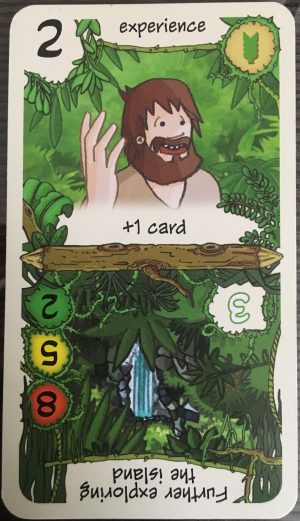
The first purchase an aspiring solo gamer needs to make is Friedemann Friese’s brilliant little deckbuilder Friday. If you’ve played Dominion, you know how the genre works: you start off with a small deck of crappy cards, and you use those cards to get better cards, crafting an increasingly powerful deck as the game progresses.
Here, you play the role of Robinson Crusoe’s Friday, and you’ll help the bumbling Crusoe brave the perils of island living until he’s strong enough to face a ship of pirates circling the island. You’ll get rid of Robinson’s negative trait cards like “Distracted” and “Weak” to make room for more helpful cards like “Experience” and “Realization.”
Friday’s crushing difficulty ensures maximum replayability, and its solitaire-only design means you’re always playing the “full game.” It takes about 25 minutes to play and costs $20 or less. Everyone needs a copy of this game.
Mage Knight
1-4 players, 60-240 minutes, ages 14+, $80 on Amazon
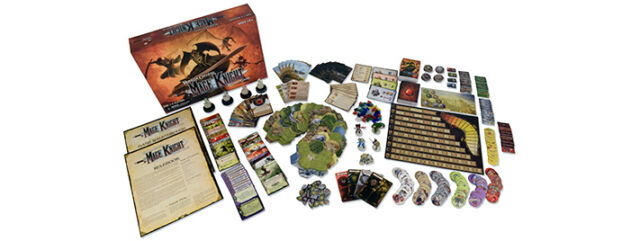
But Mage Knight consistently tops “best solo games” lists because of its immense complexity. The game seats up to four, but most Mage Knight vets recommend that you keep this one as a solo experience. Player turns can be exceedingly long (seriously, ten-minute turns are not unusual) because of the intricate card-driven puzzle you’re presented with on each turn.
If the above description hasn’t scared you off, give Mage Knight a good, hard look. If you can stomach its 3+ hour playing time and huge learning curve, you’ll be rewarded with one of the finest experiences in board gaming, solo or not.
Darkest Night (2nd Edition)
1-5 players, 120-180 minutes, ages 14+, $55 on Amazon
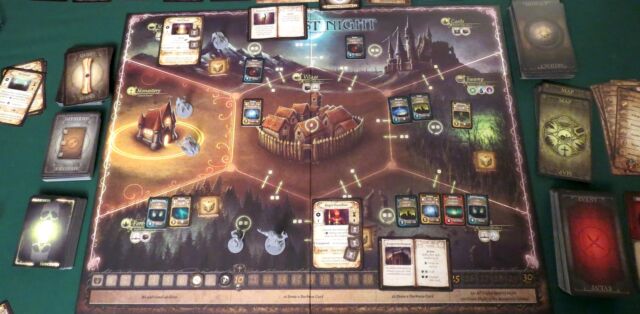
The original Darkest Night was such a success for Victory Point Games that it eventually spawned four major expansions and a handful of promos, each adding new characters and ideas to its quest to rid a kingdom of the necromancer who has been gradually tanking its property values. (Zombies and choking miasmas will do that to a real estate market.) With the second edition, everything ever produced for Darkest Night is crammed into a single package. With its twenty-nine heroes—only four of which will embark against the necromancer at a time—plus piles of quests and relics to explore, Darkest Night packs some significant replayability.
Of course, replayability isn’t the only thing that matters. Darkest Night also excels at telling spooky stories. Rather than casting your heroes as unbeatable tough guys, stealth and prudence are your best tools. Beating the necromancer requires careful... well, everything. You’ll need timing, as you place heroes in the right place to make a difference. You’ll need caution, as you sidestep terrors or the necromancer himself. And you’ll even need some investigative chops, sending your heroes chasing down leads to figure out the baddie’s weakness. There aren’t many soloable adventure games quite as imaginative—or as fine-tuned—as Darkest Night.
Nemo’s War (2nd Edition)
1-4 players, 60-120 minutes, ages 13+, $60 on Amazon

Fair warning: Nemo’s War doesn’t want you to win. This game comes from the old school of solo design, where your efforts are ranked and the top scoring tiers always seem woefully out of reach. It employs copious handfuls of dice, though in a twist that defines many of its best moments, you’re always allowed to wager your ship, crew, and even Captain Nemo himself for a boost. (If you fail the roll, whatever you wagered with takes a hit.) Expect a slow decline and you won’t be disappointed.
But that decline is entirely appropriate given the game’s subject matter. This is the tale of a man madly flailing against the spread of empire and, fittingly, it’s a struggle usually doomed to beautiful, noble failure. Ships will be sunk, the oppressed will be freed, a kraken will show up to rip a hole in the Nautilus, and you will be as likely to labor in obscurity as in infamy. If this doesn’t sell you on the game’s adventure, maybe this will: Nemo’s War is easily one of the best solo experiences ever crafted, spinning up an adventure that spans the globe, provides one agonizing moment after another, and feels great even when your crew and sanity are both fading.
Spirit Island
1-4 players, 90-120 minutes, ages 13+, $61 on Amazon

If ever there were an anti-Catan, Spirit Island would be it. All the same ingredients are present, from settlers to the towns and cities that spring up in their wake. The big difference here is that, as one of the island’s guardian spirits, you intend to push the invaders back from your shores. Each playable spirit behaves according to its own whims, whether sparking wildfires, belching magma from a nearby volcano, whipping the natives into a battle frenzy, or ebbing in and out as the tide to wash away those pesky edifices of stone and brick. It’s anything but straightforward, requiring you to carefully select which powers to emphasize as you grow in mastery over your own abilities and those of your allied spirits. Ultimately, you’ll push the invaders into precarious situations, avoid the pollution they spew across the land, and frighten them away, wipe them out—or succumb to their endless numbers.
Played solo, it’s possible to command multiple spirits or to face off against tougher colonizers. The result is a delicious revenge fantasy that lets you unmake all those colonial encroachments you have enacted in other board games.
Unicornus Knights
1-6 players, 60-90 minutes, ages 12+, $42 on Amazon

Escort missions are a hallmark of terrible video game design. They are always the missions that get skipped the second time through. But somehow, Unicornus Knights is built around an escort mission that’s both hilarious and magical. Picture this: Princess Cornelia is campaigning against the wrongful usurper of her throne. She also happens to be a tactical moron. Her plan consists of making a beeline toward the enemy castle, walking straight past fortresses occupied by vibrant (and deadly) characters. In short, her revolution is poised to be quicker than a guillotine blade’s descent—and end just as badly.
Enter you, one of Princess Cornelia’s loyal Unicornus Knights. Your goal is to steer her right, manipulating her recruitment and path to bypass the worst threats. When you can’t do that, you’ll attempt to bully, bribe, or seduce the opposition into joining your team, providing strange and useful bedfellows. (Or you could just, you know, kill them.) When the final showdown arrives, your ragtag band might include the very people you originally set out to defeat. It’s both wild and assured, with twists and fateful clashes, and it manages to make even an escort mission enjoyable.
Imperial Settlers
1-4 players, 45-90 minutes, ages 12+, $38 on Amazon
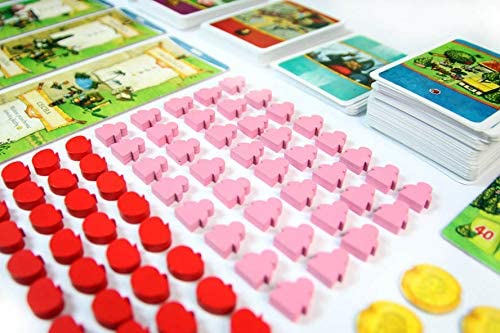
A solo mode is playable right out of the box, and designer Ignacy Trzewiczek has also published a highly recommended solo campaign variant that allows you to build up power and bonuses over multiple game sessions. Engine-building, multi-use cards, crazy combos—if you’re anything like me, you’ll love this game. A 2019 follow-up, Imperial Settlers: Empires of the North, tweaks the gameplay and plays just as well solo.
Technology - Latest - Google News
April 26, 2020 at 08:00PM
https://ift.tt/2KxiNR5
The best board games to play with your quarantined housemates - Ars Technica
Technology - Latest - Google News
https://ift.tt/2AaD5dD
Shoes Man Tutorial
Pos News Update
Meme Update
Korean Entertainment News
Japan News Update
Bagikan Berita Ini

















0 Response to "The best board games to play with your quarantined housemates - Ars Technica"
Post a Comment